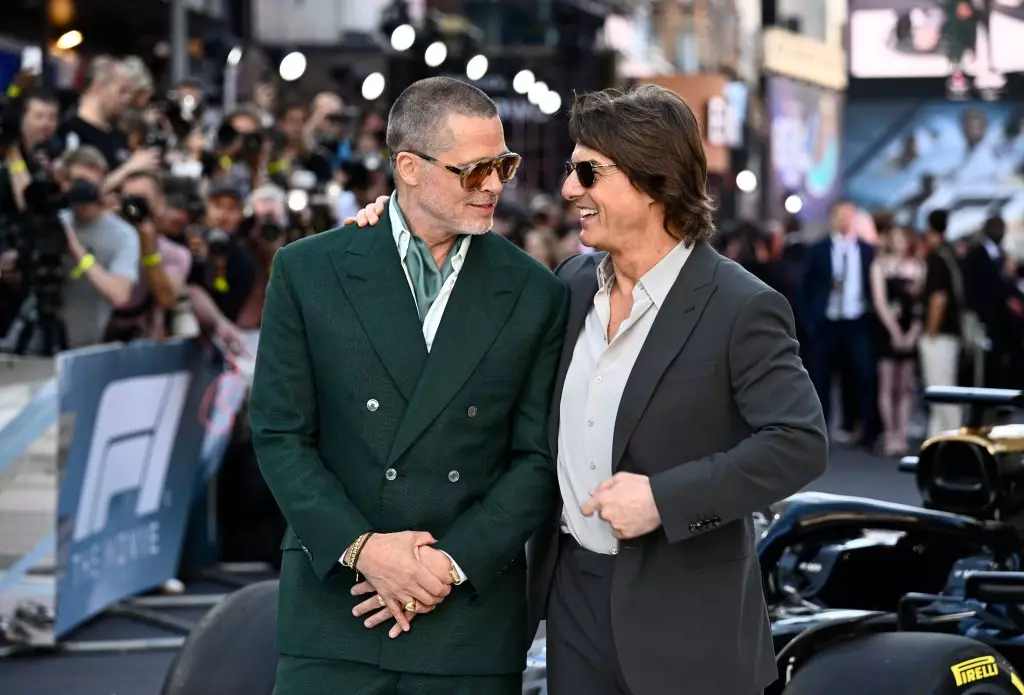The world of cinematic racing narratives is filled with unfulfilled ambitions and behind-the-scenes negotiations that often go unnoticed by audiences. A compelling example lies in the initial plans for the film *Ford v Ferrari*, which involved Hollywood heavyweights Brad Pitt and Tom Cruise. Their early engagement in the project signals not only their star power but also the level of ambition and passion that surrounded the film’s inception. Yet, despite their involvement, the project evolved into a different entity, highlighting how creative visions can shift due to logistical, financial, or personal reasons.
Pitt’s reflection on the matter reveals a deeply human aspect of filmmaking — the desire to participate in specific roles that resonate personally. His interest in embodying Ken Miles and Cruise’s wish to play Carroll Shelby exemplify how actors are often drawn to the characters that challenge them or align with their interests. Their shared desire to drive and to embody these legendary figures underscores a common misconception that star involvement alone guarantees a project’s success. Instead, it underscores how personal preferences and creative priorities significantly influence the final cast and story.
This behind-the-scenes glimpse emphasizes a broader truth: Hollywood’s creative process is often partial, influenced by multiple layers of decision-making. Studio objections, budget constraints, and evolving narratives can divert projects from their initial blueprint, illustrating that even the most star-studded ambitions can falter. The fact that Pitt and Cruise’s involvement ultimately did not materialize — yet their passion remains evident — speaks to the enduring appeal of racing stories and their potential for cinematic greatness.
The Struggles and Opportunities in Motorsport Filmmaking
Director Joseph Kosinski’s recounting of the difficulties faced during the development of a *Ford v Ferrari* project reveals much about the complex balance between artistic vision and financial pragmatism. Kosinski’s mention of studio objections related to budget constraints echoes a familiar challenge in high-octane filmmaking. Racing movies inherently involve expensive racing sequences, period-accurate vehicles, and intense location shoots, all of which escalate costs.
Despite these barriers, *Ford v Ferrari*’s 2019 release demonstrates that such obstacles can be overcome with meticulous planning and a compelling story. The film’s commercial success ignited speculation about a sequel, with Kosinski implying that the audience’s appetite will determine the project’s future. This highlights a core truth: audience reception can be the ultimate arbiter in high-budget genre filmmaking. When a racing film resonates with viewers, it opens doors for sequels and expanded cinematic universes, capitalizing on the renewed interest in motor racing.
Additionally, the film’s partnership with Formula 1 and its teams symbolizes a strategic approach to authenticity and marketing. Incorporating real racing entities lends credibility to the story and enhances viewer engagement. It also signals a shift toward more immersive storytelling, where authenticity matters as much as narrative coherence. The success of *Ford v Ferrari* demonstrates that with careful collaboration, racing movies can transcend mere spectacle to become culturally significant narratives.
Stars, Sequel Dreams, and the Future of Racing Films
Brad Pitt’s openness about returning to racing projects reveals a persistent passion for the genre. His mention of potentially revisiting a racing role, specifically in a sequel, showcases the ongoing desire among actors and filmmakers to explore these adrenaline-fueled worlds further. His playful speculation about characters like Sonny Hayes or setting speed records at the Bonneville Salt Flats suggests a nuanced understanding: racing stories are versatile, capable of spanning different eras or racing disciplines.
Moreover, Pitt’s comment underscores a broader industry trend—stars leverage their involvement to keep racing narratives alive and evolving. The fact that actors like Pitt and Cruise are willing to reconsider roles reflects a recognition of the cultural and commercial viability of racing stories. Such openness fosters a fertile environment for future projects, blending high-octane action with compelling character arcs.
However, the uncertainty surrounding these ambitions also hints at the unpredictable nature of filmmaking. Sequel development depends not only on audience reception but also on production feasibility, actor availability, and studio willingness. While Pitt’s enthusiasm is genuine, the realities of Hollywood mean that even the most promising projects require strategic planning and a bit of luck.
At its core, this landscape invites a broader reflection: racing stories are more than just adrenaline rushes. They symbolize human ambition, perseverance, and the thrill of pursuit. Their cinematic retelling offers audiences a gateway into worlds where speed, danger, and determination collide. With stars like Pitt voicing their interest and industry giants considering sequels, the future of racing films looks promising — provided they balance authenticity with compelling storytelling, all while navigating the inevitable hurdles of production.
